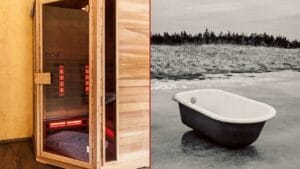The best time to use a sauna depends on what you’re aiming to get out of it. Whether it’s boosting energy, speeding up recovery, or just winding down, timing can make a big difference. Some like to kick off their day with a sauna, while others find it perfect post-workout or right before bed.
In this article, we’ll explore when to use a sauna to get the most out of each session.
When is the Best Time to Use Saunas?
The best time to use a sauna varies depending on what you want to achieve. Some people prefer to start their day with a sauna session, while others swear by it after a workout or before bed.
Each time of day offers unique benefits, so let’s break it down.
- First Thing in the Morning:
- Using a sauna in the morning can give you an energy boost to jumpstart your day. A quick 10-15 minute session can help increase circulation, wake up your body, and improve your overall mood. It’s like a reset button to clear your mind and get you ready to take on the day ahead.
- Post-Workout Sauna:
- Right after a workout is one of the best times to use a sauna. The heat helps relax sore muscles, reduce stiffness, and improve blood flow, which speeds up recovery. After pushing your body, it’s an ideal way to unwind while promoting recovery at the same time.
- Evening Sauna:
- A sauna session in the evening is great for helping you relax and unwind. It can ease stress, soothe any tension built up throughout the day, and even prepare you for better sleep. By the time you’re done, you’ll likely feel calmer and more ready for bed.
- Pro Tip: Use Ice Baths After Saunas
- Using an ice bath after a sauna immensely improves recovery and boosts circulation even more. The contrast between heat and cold encourages your body to adapt quicker, reducing muscle soreness and improving overall recovery. Many athletes and sauna enthusiasts swear by alternating between saunas and ice baths for maximum results.
Best Time of Year for Sauna Use
The best time to use a sauna can vary based on the season, climate, time zone, and even your accessibility to the sauna itself.
Winter Months
For most people, especially in colder climates or those living in temperate time zones (e.g., North America, Europe), winter is the ideal season for sauna use. The contrast between the freezing outdoor air and the sauna’s warmth is not only comforting but also provides relief for stiff muscles and joints.
If you live in regions with harsh winters, like the northern U.S., Canada, or Scandinavia, using a sauna in the late afternoon or early evening is optimal. It helps warm you up and relax your body as temperatures drop further in the evening.
Summer Months
In hotter climates or during summer, saunas can still be beneficial, but you might want to consider early mornings or late evenings when the weather cools down. In tropical or desert regions (e.g., Southeast Asia, parts of Australia, or the Middle East), midday heat combined with a sauna can be overwhelming, so avoid sauna sessions in the middle of the day.
Instead, using it before sunrise or after sunset is better for maintaining comfort and hydration.
Spring and Fall
These transitional seasons are a sweet spot for sauna use. In places with fluctuating climates, such as parts of Europe, North America, or Australia, spring and fall provide a moderate balance. For spring, consider midday sessions when the temperatures are still rising but not too hot.
In autumn, late afternoon or evening sessions work best as the temperatures start to drop and you prepare for cooler nights.
Climate & Accessibility
Accessibility also plays a role in sauna use. If you have an outdoor sauna, you’ll want to consider your local weather. During rainy or humid seasons (e.g., in Southeast Asia or tropical areas), indoor saunas or those with covers will be more convenient to access without worrying about slippery surfaces or wet weather.
Additionally, high-altitude locations may experience extreme cold during certain times of the year, so plan for midday sauna sessions when the outside temperature is at its warmest
Conclusion
Finding the best time to use a sauna depends on your daily routine, goals, and even the climate you live in. Whether you’re looking to kickstart your day, recover after a workout, wind down in the evening, or even enhance your recovery with contrast therapy, saunas offer flexibility.
The key is to match your sessions with the time that works best for your body and schedule, while also considering seasonal changes. No matter when you sauna, it’s a routine worth sticking to for its physical and mental benefits.




